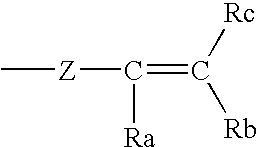Cosmetic compositions having in-situ hydrosilylation cross-linking
a technology of hydrosilylation and composition, which is applied in the field of compositions and methods for forming films on a surface, can solve the problems of limited durability, transfer resistance, water resistance, etc., and achieve the effects of high elastomeric performance, prevent migration, and water resistance and durability
- Summary
- Abstract
- Description
- Claims
- Application Information
AI Technical Summary
Benefits of technology
Problems solved by technology
Method used
Image
Examples
example 1
[0071] A lip gloss according to the invention is provided as a two-part formulation comprising a base coat and a top coat. The base coat comprises the cross-linkable organosiloxane polymer and other ingredients as shown in Table 1.
TABLE 1Lip Gloss Base CoatDow Corning 8-8024 Base70Cyclopentasiloxane20Pigment Blend10
[0072] The Dow Corning 8-8024 Base comprises a polydimethylsiloxane polymer having reactive dimethylvinyl end groups and dimethyl, methylhydrogen siloxane.
[0073] The top coat, which comprises the curing agent, is kept separate from the base coat until application to the lips. Two top coat formulations (Sample 1 and Sample 2) are provided in Table 2.
TABLE 2Lip Gloss Top CoatSample 1Sample 2Dow Corning 8-8024 Curing Agent7070Dow Corning 200 ® Fluid (1,000 CST)30—Dow Corning 200 ® Fluid (30,000 CST)—20Dow Corning 200 ® Fluid (100,000 CST)—10
[0074] The top coat comprises the curing agent Dow Corning 8-8024 which contains a platinum catalyst. The Dow Corning 200® Fluids e...
example 2
[0075] The transfer resistance of the lip gloss formulations of Example 1 was examined in comparison to the commercial lip coloring products Lipfinity™ (Procter & Gamble) and Lip Polish™ (Maybelline) using a modification of the transfer resistance testing protocol of U.S. Pat. No. 6,074,654, the disclosure of which is hereby incorporated by reference. The testing protocol is described below.
Transfer Resistance Test Method
[0076] This method may be utilized to determine the water and oil transfer resistance and adhesion properties of a cosmetic film. This test predicts the ability of a cosmetic film to resist color transfer to objects contacting the skin. Such objects include clothing, handkerchiefs or tissues, napkins and implements such as cups, glasses and table wear, and oily fingers or objects such as oily foods.
[0077] Films formed from cosmetic compositions exhibit a degree of transfer resistance directly proportional to the hardness and solvent-resistance of the film. The h...
example 3
[0109] The flexibility of the lip gloss formulations of Example 1 were examined using a modification of the flexibility testing protocol described in patent U.S. Pat. No. 6,074,654, the contents of which are hereby incorporated by reference. The flexibility of a cosmetic film is an important to both the durability (long-wear) and comfort properties of a cosmetic film.
[0110] Flexibility is measured by the latex stretch test. This test predicts the ability of the color film to resist flaking or peeling types of failure after application by movement of the skin during normal activities. The flexibility latex stretch test is based on the weight-loss measurement before and after the latex stretch.
Equipment:
[0111] (1) Ansell Industrial technicians unlined gloves (12″ length, 17 mil) USDA Accepted #390, Size 9; [0112] (2) Slanted Eyeshadow Brushes from Avon Products, Inc. [0113] (3) Analytical balance (4 decimal places); and [0114] (4) Ruler.
Procedure: [0115] (1) Cut a 1 inch wide ba...
PUM
| Property | Measurement | Unit |
|---|---|---|
| molecular weight | aaaaa | aaaaa |
| diameter | aaaaa | aaaaa |
| weight | aaaaa | aaaaa |
Abstract
Description
Claims
Application Information
 Login to View More
Login to View More - R&D
- Intellectual Property
- Life Sciences
- Materials
- Tech Scout
- Unparalleled Data Quality
- Higher Quality Content
- 60% Fewer Hallucinations
Browse by: Latest US Patents, China's latest patents, Technical Efficacy Thesaurus, Application Domain, Technology Topic, Popular Technical Reports.
© 2025 PatSnap. All rights reserved.Legal|Privacy policy|Modern Slavery Act Transparency Statement|Sitemap|About US| Contact US: help@patsnap.com



